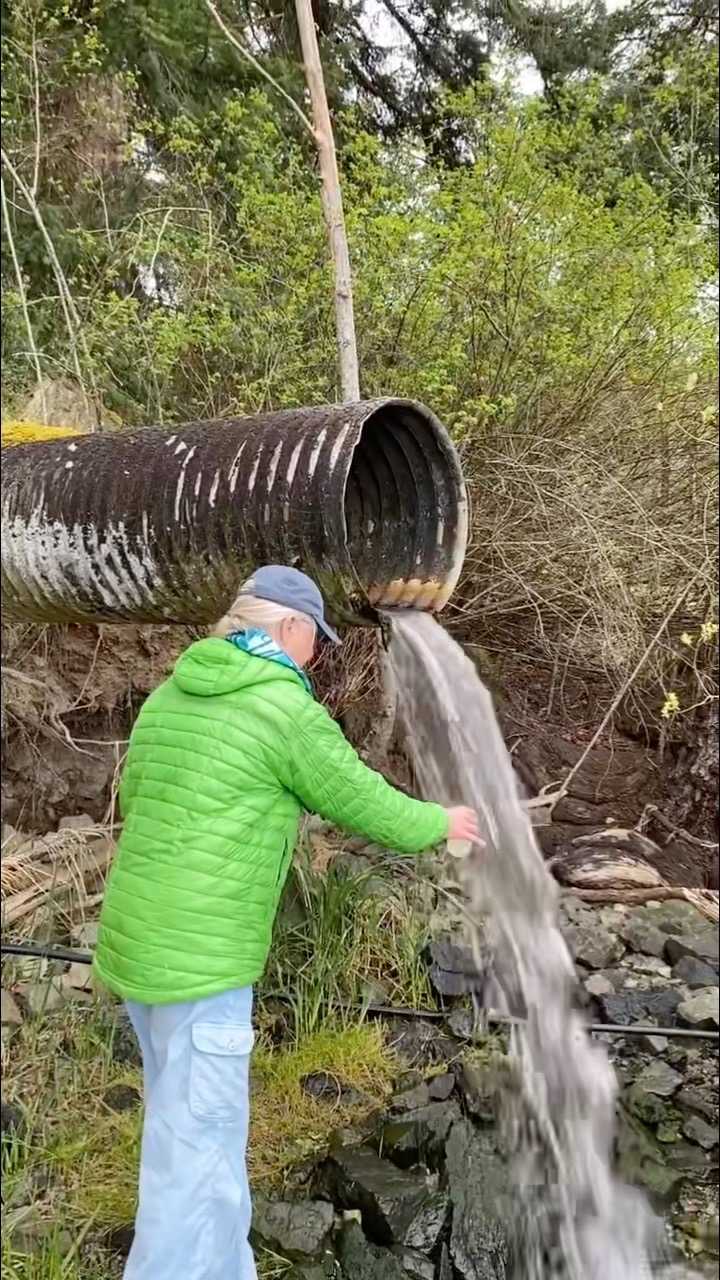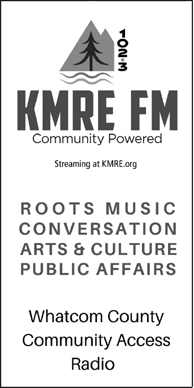Editor’s Note: Whatcom Watch has entered a cooperative agreement with Salish Current. When possible, we will share each other’s content. Salish Current, an online-only news organization, covers the North Sound area and Whatcom Watch mainly covers Whatcom County issues. Visit https://salishcurrent.org.
by Luisa Loi
Part II
High bacteria counts in stormwater are prompting concerns, as volunteer citizen scientists walk Anacortes and Bellingham shores to help track outfall water quality.
Forever Chemicals
According to RE Sources, 75 percent of toxic chemicals in the Puget Sound were introduced by stormwater.
Squalicum Creek
In 2024, RE Sources tested Squalicum Creek — rated as “threat” — for a second year to detect “forever chemicals” or PFAS, short for per- and polyfluoroalkyl substances, which derive from household and industrial products and can have significant effects on the health of humans and wildlife “even in extremely low concentrations,” according to the nonprofit.
While the majority of the samples contained less than the typical 50 parts per trillion of PFAS for streams in Washington, four sites in Squalicum Creek had concentrations that exceeded this standard, reaching 393.3 parts per trillion just downstream of Hannegan Road.
According to RE Sources, this could mean that one or more sources are releasing the chemicals into the creek, with two suspects being a firefighting training facility that may have discharged firefighting foam – which contains PFAS – into the creek, or a truck wash station that discharged wastewater into the creek.
More tests are necessary to identify the source with certainty, but RESources recommends that people and pets avoid the creek.
First Flush Events
Valderas said that contamination tends to be worse in the summer, when after long periods of dry weather, all the bacteria and chemicals that have piled up over time are flushed at once after a rain in what she called a “first flush event.”
Yet, the high bacteria levels that were found recently at the Olive or Bennett outfalls were not preceded by rain, McDade said.
At Olive, despite the dry weather, volunteers noticed a stronger-than-expected water flow. Due to its brown color, foam and “disgusting” smell that left volunteers “disturbed,” McDade thinks it was the result of a sewage system leak, which the city said is likely due to the aging pipes.
While there was no extra water gushing out of the Bennett outfall, the city suggested the high bacteria counts could have originated from a breeding ground inside the stormwater pipes.
McDade said she’d like the City of Bellingham to do source tracing more frequently, but understands that the city is facing staff and resource shortages.
According to RE Sources, the city “is not required to sample stormwater regularly to see if they’re within the limits of their pollution permits.”
Valderas suggested that Bellingham, despite conducting follow-up investigations, may be struggling to identify specific sources because the stormwater system seems to be more underground, meaning that the further down a sample is taken from a stream, the more sources may have contributed to the contamination.

courtesy photo: Shanti Nelson
A volunteer collects a sample from the Fidalgo Bay Road stormwater outflow near Anacortes.
Surveying in Anacortes
The Friends of the Salish Sea (Friends) have also been surveying about 50 out of over 70 outfalls in Anacortes, according to Valderas.
Scientists find obvious signs of pollution at the C Street outfall. The Friends work in partnership with the City of Anacortes, which then investigates the contamination and takes action to mitigate the issue.
In a recent accident, for example, a resident mistakenly hooked up their sewer line to the stormwater line, an issue the city resolved, she said, adding that this is a common occurrence.
Despite improvements, money and staff remain a challenge, according to Stormwater Manager Aaron Esterholt.
The city has retrofitted eight acres worth of drainage basin this year and is in the process of retrofitting the D Avenue area with more bioretention cells, he said. Next year, the city will remove a storm pond and add a modular wetland, a treatment system that filters out pollutants from runoff.
While pollution is a concern in the region, it also doesn’t affect Anacortes enough to warn people against partaking in recreational activities in the area, he said. To keep things from actually getting bad, however, would require some effort from people.
“Right now we don’t have an issue, we’revery lucky we don’t, but it doesn’t mean that tomorrow we won’t,” Esterholt said.
One Small Habit Change at a Time
Esterholt finds that many people hold the incorrect belief that stormwater goes into the sewage system and gets treated before being discharged into the sea. On the contrary, most stormwater doesn’t get treated at all.
While it might sound efficient to treat both in the same system, funneling wastewater and stormwater into the same pipes can overwhelm the system during heavy rains, leading to sewage being discharged into the waterways, Valderas said.
People also tend to be unaware of the many ways they’re contributing to stormwater pollution, she and Esterholt said.
Often, the pathogens found in stormwater are none other than the ghosts of the dog poop left unscooped around town. Though sparing someone from the mortifying experience of stepping on raw sewage should be common sense, some might be more compelled to clean after their pets if they knew they’d be preventing bacteria, viruses and parasites from being swept into the stormwater system and poisoning streams with poop water.
Washing cars at home rather than at a car wash — where water is captured and recycled — causes the soapy water to end up in streams and strip the natural slime coat that protects fish from diseases and parasites, he said.
Chemicals can affect water temperature and pH and kill microorganisms that are at the base of the food chain, he said. Washing paintbrushes outside, spraying fertilizer to a garden, applying moss killer onto roofs all contribute to contaminating our streams.
In the case of Squalicum Creek, the water gets too hot to support salmonids in the summer months, according to RESources.
Salmon also face other threats. According to Valderas, streams tend to show high levels of 6PPD — a chemical used to prevent tires from degrading — whenever they intersect with a roadway.
“It is so toxic to coho that you need the equivalent of a few drops in an Olympicsize swimming pool for it to kill them,” she said.
While the tire industry looks at finding a safer alternative, she recommends keeping tires properly inflated to minimize the release of the tire dust.
In the absence of appropriate sediment control, residue from construction sites, including dirt, can deposit on the riverbeds where salmon lay their eggs and spawn, Esterholt said. Even sediment from dead leaves can be harmful to fish habitat.
Protecting Your Health
Though there isn’t any data about people getting sick from being exposed to stormwater pollution in either city, McDade has heard people saying they got an infection right after swimming in Bellingham Bay, though these anecdotes have not been confirmed.
By reporting any sickness that is suspected to have been caused by swimming in the Puget Sound to their local health departments, community members can help researchers and jurisdictions better understand the impacts of pollution and keep people safe.
But if swim you must, the experts recommend not swimming in front of outfalls, waiting at least 48 hours after a rain event before swimming, showering after a swim, avoiding seafood harvested out of inner Bellingham Bay and staying away from the water if you are immunocompromised or have any open wound — recent piercings and tattoos included.
See the original article here:
https://salish-current.org/2025/06/18/troubledwaters-stormwater-bacteriacounts-stir-up-concerns/
__________________________________-
Luisa Loi is a freelance reporter for Salish Current. After graduating from Western Washington University in 2022, she wrote for the Whidbey News-Times and Whatcom Watch. She mostly enjoys writing about the environment, social issues and people with unique stories, crafting, exploring the Pacific Northwest and finding her next binge-able TV show.





























